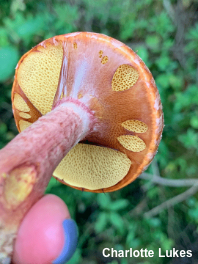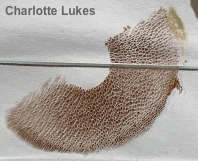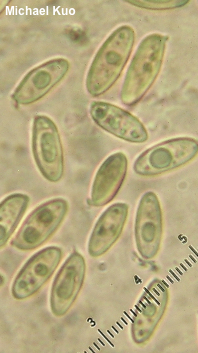| Major Groups > Boletes > Suillus > Suillus spectabilis |

|
Suillus spectabilis [ Basidiomycota > Boletales > Suillaceae > Suillus . . . ] by Michael Kuo Here is a distinctive species of Suillus, found throughout the North American range of its mycorrhizal partner, tamarack (also known as eastern larch). Suillus spectabilis features a sticky red cap that is adorned with grayish patches, and a gelatinous red partial veil that leaves a sticky ring on the upper stem. Above the ring, the stem is smooth and yellow, but below the ring it is red and fibrillose. Further distinguishing features include the purplish brown spore print and, under the microscope, fairly large spores. Compare Suillus spectabilis with Suillus clintonianus (formerly known in North America by the name Suillus grevillei, which is a European species), also associated with tamarack but featuring a smooth cap and a white to yellowish partial veil—and with Suillus spraguei (also known as Suillus pictus), which is associated with eastern white pine and features a drier, shaggier cap. Fuscoboletinus spectabilis and Boletinus spectabilis are former names. Thanks to Charlotte Lukes for documenting, collecting, and preserving Suillus spectabilis for study; her collection is deposited in The Herbarium of Michael Kuo. Description: Ecology: Mycorrhizal with tamarack; growing gregariously in low-lying, swampy areas; usually terrestrial, but sometimes growing from well-rotted stumps and logs; late summer and fall; originally described from upstate New York; widespread in North America throughout the natural range of tamarack; also reported in Finland. The illustrated and described collection is from Wisconsin. Note: The illustrated and described collection is apparently a bit small in comparison to "typical" collections. Cap: 4–5 cm across; convex becoming broadly convex; sticky when fresh; with grayish to brownish appressed, fibrillose patches and scales over a pinkish red to red ground; the margin sometimes hung with grayish partial veil remnants. Pore Surface: Yellow; not bruising, or bruising slightly pinkish; 1–2 angular pores per mm; tubes to about 5 mm deep. Stem: 4–6 cm long; 1–1.5 cm thick; more or less equal; bald and yellow above the ring; red and fibrillose below. Partial Veil: Glutinous and red when fresh, covering the pore surface and cap; after breaking, disposed as grayish to reddish, sub-fibrillose patches on the cap and, on the stem, as a red, gelatinous ring. Flesh: Pale yellow in cap and upper stem; darker yellow in stem base; not changing when sliced. Odor and Taste: Not distinctive. Chemical Reactions: Not tested on the described and illustrated specimens; KOH reported by Smith & Thiers (1971) as dark green on the flesh. Spore Print: Dark purplish brown. Microscopic Features: Spores 10–13 x 3.5–5 µm; subfusiform; smooth; yellowish to dull golden in KOH. Basidia 30–35 x 4–6 µm; subclavate; 4-sterigmate. Cystidia in bundles; 25–60 x 4–6 µm; sometimes poorly defined; subcylindric to subfusiform; thin-walled; reddish brown-encrusted in KOH. Pileipellis an ixocutis; elements 5–10 µm wide, smooth or slightly encrusted, yellow to hyaline in KOH. Clamp connections not found. REFERENCES: (C. H. Peck, 1872) O. Kuntze, 1898. (Murrill, 1909; Pomerleau & Smith, 1962; Snell & Dick, 1970; Smith & Thiers, 1971; Smith, Smith & Weber, 1981; Schalkwijk-Barendsen, 1991; Both, 1993; Bessette et al., 2002; McNeil, 2006; Klofac, 2013; Bessette et al., 2016; Nguyen et al., 2016; Knudsen & Taylor, 2018.) Herb. Kuo 09172101. This site contains no information about the edibility or toxicity of mushrooms. |
© MushroomExpert.Com |
|
Cite this page as: Kuo, M. (2021, October). Suillus spectabilis. Retrieved from the MushroomExpert.Com Web site: http://www.mushroomexpert.com/suillus_spectabilis.html |



